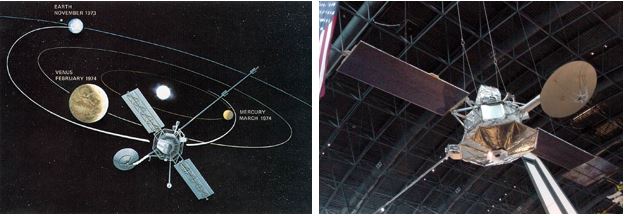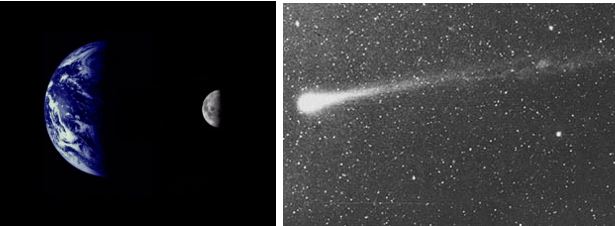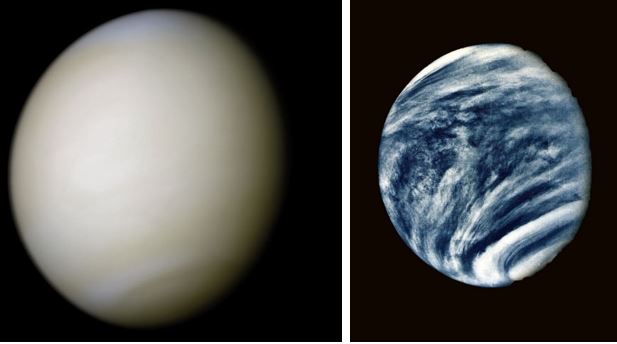A unique opportunity presented itself in 1973 to send a spacecraft to visit both Venus and Mercury in a single mission. Using gravity assist, a technique theorized for decades but never used before, under favorable conditions a spacecraft sent to one planet can use that planet’s gravitational force to essentially slingshot on to its next target. The method saved the cost of additional fuel and a larger rocket that would be necessary to launch the heavier spacecraft as well as time to get to the ultimate destination. In 1969, NASA approved a plan to send a spacecraft to Mercury, using Venus for a gravity assist. The mission, managed by the Jet Propulsion Laboratory (JPL) in Pasadena, California, became Mariner 10. It was the last in the Mariner series of very successful planetary spacecraft that revealed many secrets about the inner solar system.
Planetary scientists had learned a great deal about Venus from both Earth-based observations and previous American and Soviet spacecraft encounters. Mariner 10’s goals at Venus were to add to existing knowledge, and beam back the first ever close-up photographs of the planet to reveal the structure of the upper atmosphere. To accomplish these and other goals, Mariner 10 carried out seven scientific experiments – the Television Photography System consisting of two telescopes to image the planet; an infrared radiometer to calculate the temperature of Venus’ atmosphere; an ultraviolet spectrometer primarily to detect any atmosphere around Mercury; plasma detectors to study the solar wind inside the orbit of Venus for the first time; a charged particle telescope to study cosmic radiation; magnetometers to detect any magnetic field around Venus and Mercury; and a celestial mechanics and radio science experiment to investigate Venus and Mercury’s mass and gravitational characteristics.
On Nov. 3, 1973, Mariner 10 lifted off from Cape Canaveral, Florida, to begin its journey to Venus and Mercury. Shortly after leaving Earth orbit, the spacecraft calibrated its camera system by taking photographs of the Earth and Moon. The first photos of Earth were taken just 16 hours after launch at a distance of 120,000 miles. The spacecraft photographed the Moon’s north polar region, an area that was poorly imaged by earlier spacecraft. Planned course corrections 10 days after launch and on Jan. 21, 1974, adjusted the fly-by distance to within 8 miles of the target. The three-month cruise to Venus included several spacecraft malfunctions, overcome by the dedicated ground control team at JPL. In late January, Mariner 10 made ultraviolet measurements of Comet Kohoutek, adding to observations by ground-based facilities as well as the astronauts aboard the Skylab space station in Earth orbit.
The spacecraft approached Venus from its night side, and passed within 3,584 miles of the planet on Feb. 5, 1974. During the fly-by, Mariner 10 performed flawlessly and sent back information about Venus’ atmosphere and environment and beamed back the first close-up images of the cloud-shrouded planet. Photographs taken in visible light revealed a featureless orb, but using ultraviolet filters revealed extensive cloud details. A series of images confirmed terrestrial observations that Venus’ cloud tops rotate with a period of four days. In all, Mariner 10 returned 4,165 pictures of Venus.
Mariner 10 contributed significantly to our understanding of Venus during its fly-by. It confirmed that Venus lacks an appreciable magnetic field to deflect the solar wind, but its considerable atmosphere and ionosphere act to modify the stream of particles emanating from the Sun. The ionosphere in particular creates a bowshock, preventing the particles of the solar wind from penetrating into the atmosphere. The celestial mechanics experiment found that Venus is 100 times closer to being a perfect sphere than the Earth. The spacecraft found that temperatures at Venus’ cloudtops are the same on both the day and night sides. Data from Mariner 10’s radio science instrument allowed scientist to build detailed pressure, density, and temperature profiles of the Venusian atmosphere. For the most part temperatures increased toward the surface, but Mariner 10 found four temperature inversions higher in the atmosphere likely caused by cloud formations.
The gravity assist at Venus was highly successful, and Mariner 10 continued on to Mercury to conduct the first ever encounter with that planet on Mar. 29, 1974. The spacecraft’s unique trajectory enabled it to return for two additional fly-bys of the innermost planet at six-month intervals.




























